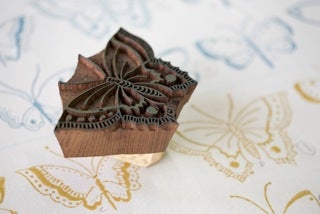Blocks of beauty: A dying Indian art form
Annie Deakin looks at the Indian block printing process used to decorate fabric and speaks to one lady attempting to promote these ancient skills

Last week, while travelling around India, I was on the hunt for original wooden print blocks. I’ve long admired the dying art of block printing; the slow process itself, the finished weathered fabric and the tools.
I’m not alone in this appreciation. A recent visit to a small, traditional block?printing workshop in Delhi inspired Vanessa Arbuthnott to design her latest collection of block printed fabrics made in India. In an increasingly mechanised world, Arbuthnott wants to support these hand-printing skills.
Handblock printing is one of the earliest, simplest and slowest forms of textile printing. Some consider it the most artistic; the distressed look created by block printing can't be replicated by machine. The design is first carved out of a wooden block. The printer then covers the block with dye and presses it firmly onto the cloth striking it smartly on the back.
‘I find the little reminders that they have been printed by man and not machine so charming. A small imperfection here, perhaps a not dead?straight line there all add to their enchantment and uniqueness,’ says Arbuthnott.
‘I love the rougher, more rustic and less precise marks of block printing and also the irregularities of block printing.’ Her new collection comprises three designs – Life and Eternity (a traditional paisley fertility symbol), Butterfly Dance and Simple Ticking.
Block printing is rarely done in the UK so Arbuthnott and her husband booked flights to India, ignoring the advice of friends in the business. ‘I had been warned off the project by a friend who imports block printed fabric from India for several reasons. Firstly she warned that the fabric would never be delivered on time, and secondly it would be difficult to maintain quality. I decided to go to Delhi, Jodhpur and Rajasthan, the traditional home of block printing to explore the print workshops and to hopefully support this dying art in some small way.’
She visited ten block printers of varying sizes. ‘We were given wonderful warm welcomes at every workshop with endless mint tea.’ The first challenge was accepting that the Indian pace of life is slower than that in England. Meetings were long; tea and nibbles was priority for the first hour and business decisions were an unhurried affair. Slow Delhi traffic meant driving a few miles took several hours and meetings were drawn out. ‘We learnt that we had to be wary of the Indian tendency to say "yes" to absolutely everything. One piece of good advice we were given was to trust the person who occasionally said "no, we can’t do that."'
Many of the printers tried to persuade her to switch to rotary printing and seemed surprised that she wanted to use their block printers. ‘We had a tick list of conditions as a guide to help us choose the right printer.’ She wanted a workshop with good working conditions for the employees, somewhere allowing good lead times for repeat orders and offering light fast scores for the block printed fabric. ‘We chose one in Delhi, who had developed a technique to print 25-metre pieces of fabric rather than the traditional five metre pieces. The tables are five metres long.’
The ordering process was trying. 'I think it would be difficult to run a busy mail order business on solely block printed fabric from India but by having the UK back-up it took the pressure off the Indian block printers,’ she says.
To keep the carbon footprint down, Arbuthnott was determined to source the organic cotton and linen cloth in India. The problem was, as she learnt at an International Textile Fair in Delhi, the printers live in the north and the weavers in the south. ‘Finding a reliable weaver took months and necessitated a visit from a middleman. We employed him to inspect the cloth and factory in Southern India.’
‘Then came the big disappointment,’ recalls Arbuthnott. The organic linen supplies were delayed. When it arrived, the new cloth was woven too wide for the printer’s tables. ‘There was chaos in Delhi due to the Commonwealth Games, religious festivals (about 100 a year) and a bereavement at the printers.’
The first stock took four months longer than promised; as a last resort, Arbuthnott got the designs screen-printed in London because she urgently needed to send out her new brochure. ‘This was certainly not a cost-saving mission,’ says Arbuthnott. ‘It quite rightly costs more per metre to produce than my UK printed fabrics because it is printed by man and not machine.’
While in India last week, I picked up three hand-carved wooden blocks from a dusty roadside stall. They are now sitting on my mantelpiece, full of promise, history and craftsmanship, each with unique swirls and patterns. From India with love.
Annie Deakin is interiors writer for sofa and interior design website mydeco.com.
Join our commenting forum
Join thought-provoking conversations, follow other Independent readers and see their replies
Comments